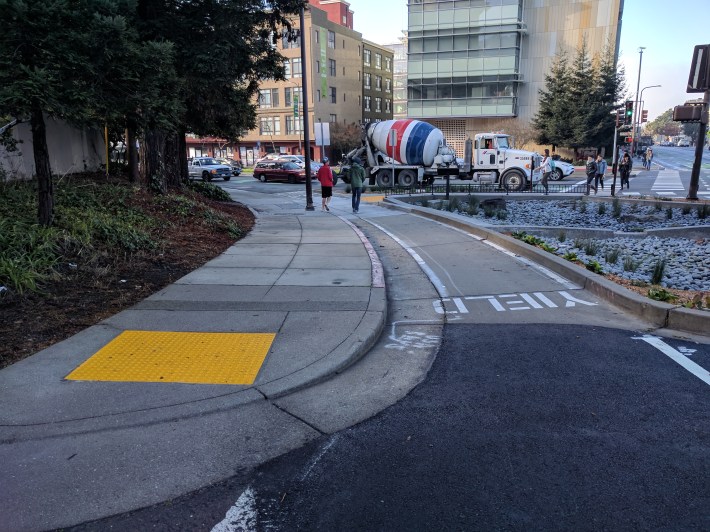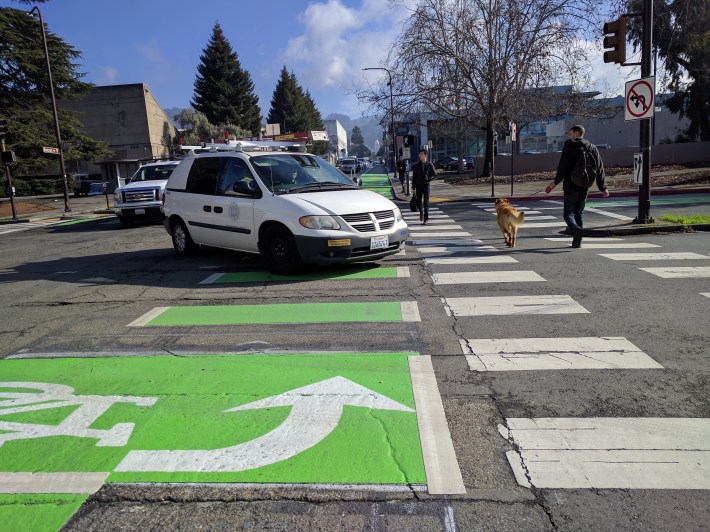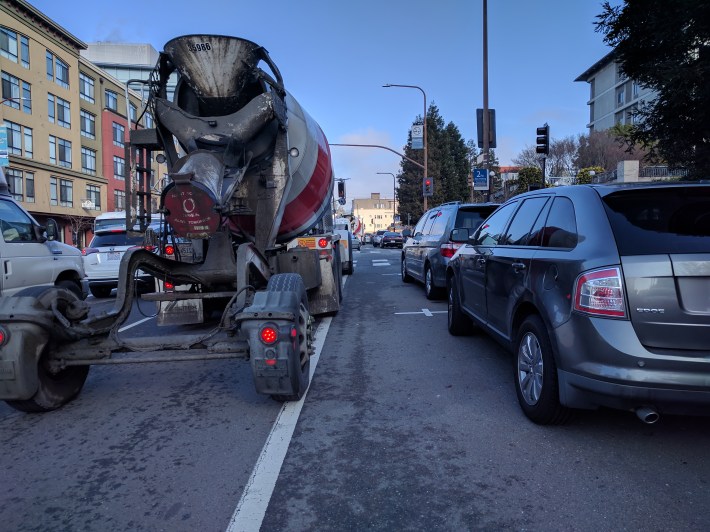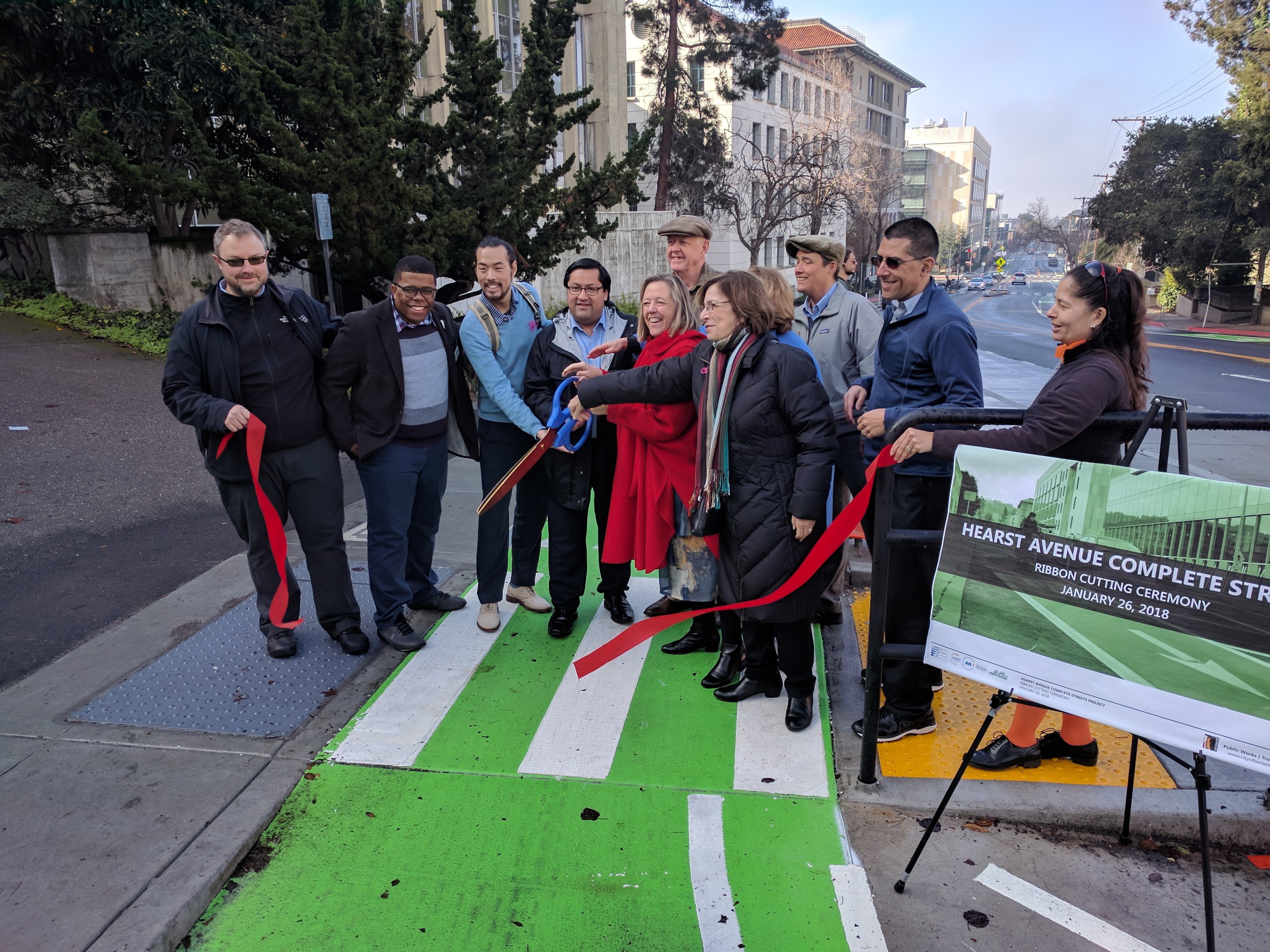Berkeley christened two protected bike lanes today, one on Hearst Avenue on the north side of the UC Campus, and the other on Bancroft, on the university's southern border. "Hopefully, this is the first of many," said Berkeley Mayor Jesse Arreguin, during the celebratory event on Hearst. "Let's make every street in our city a complete street."

“Hearst Avenue and Bancroft Way set a high bar for well-designed, well-connected streets that make life better for everybody, whether you’re walking, biking, driving, or taking the bus. I love that people biking don’t have to compete with AC Transit, buses are moving efficiently, and it’s easier than ever to walk to campus,” said René Rivera, Executive Director of Bike East Bay.
As the above photo shows, the complete streets project on Hearst features bus-boarding islands, so AC Transit and other buses aren't jostling with cyclists to get to the curb to pick up and drop off passengers. "1,600 people board here per day, with a bus every six minutes," said Greg Harper, a director at AC Transit. "This is a multi-modal design."
All the participants in the events stressed the importance of cooperatively serving the safety and needs of bikers, walkers, bus riders, and local businesses on the same streets. A UC Berkeley transportation survey, conducted last year, found that over 65 percent of students already walk or bike, and only 37 percent of faculty and staff drive alone to work. The aim is to make the streets even safer and more inviting to those who choose not to drive to the campus.
"Two years ago at Sunday Streets we did a mock-up of this with duct tape and cardboard," said Rivera, pointing at the protected bike lane and bus boarding island. "Thank you to everyone who made our duct-tape dreams into reality today."
Farid Javandel, Transportation Manager for the City of Berkeley, said these designs are just the start of the kind of 'complete streets' features the city wants to put everywhere. But he differentiated Hearst and Bancroft Way, where things are more of a work-in-progress. "On Bancroft, we piggybacked on a paving project," he said. "Think of this as an interim project." Bus-only lanes were painted, but rather than build bus-boarding islands to make way for a protected bike lane heading west on Bancroft the city opted for a two-way bike lane on the left side of this one-way street. This was hailed as a victory by complete streets advocates, but there are some issues.
Experience has shown that two-way bike lanes are best reserved for waterfronts (such as the Embarcadero) or other streets where intersections aren't an issue. Two-way protected bike lanes, while better than unprotected bike lanes, are less than ideal on a city street. It was frightening to see automobiles routinely making illegal lefts at the intersection with Oxford, right across the bike lane and potentially right into the path of a cyclist who could be coming from either direction.
As pointed out in the previous post, the bike lane also requires westbound cyclists to merge across three lanes of traffic on either side of the campus, as they go from right to left and then left to right a few blocks later. To be safe, two-way protected cycle paths really need signalized intersections with separate bike phases, with concrete bollards and signs placed as far into the intersection as possible to prevent fast and sweeping (not to mention illegal) left turns. Javandel said that, in a couple of years, they will look at adding such features or adding concrete bus-boarding islands, like on Hearst, and creating one-way protected lanes on both sides of the street.
Still, the building of protected bike lanes, transit-only lanes, and complete streets has to start somewhere. Turning onto Oxford Street, with its narrow bike lane that sandwiches cyclists between parked cars and fast-moving traffic, underscores how much better the facilities now are on Bancroft and Hearst. It was nice to see Berkeley celebrating this progress, thanks to the advocacy work of Bike East Bay and the participating city and county agencies.
More images and impressions below.









